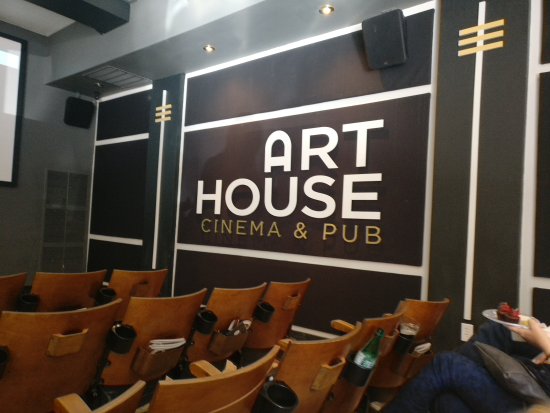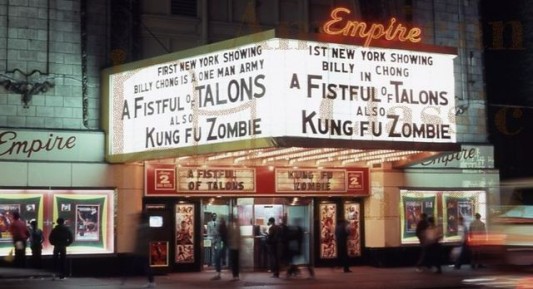 The grindhouse and the arthouse: two distinct modes of cinema that would appear to be leagues removed, and for the most part they are. The links between, say, THE REMAINS OF THE DAY and SWITCHBLADE SISTERS are obviously pretty tenuous. Yet there is a type of art film that fits in quite well with the grindhouse ethos, with the only real difference being that such films have a (purportedly) more artistic intent than grindhouse fare.
The grindhouse and the arthouse: two distinct modes of cinema that would appear to be leagues removed, and for the most part they are. The links between, say, THE REMAINS OF THE DAY and SWITCHBLADE SISTERS are obviously pretty tenuous. Yet there is a type of art film that fits in quite well with the grindhouse ethos, with the only real difference being that such films have a (purportedly) more artistic intent than grindhouse fare.
Saucy arthouse fare, or “artsploitation” (a term that, to give credit where credit is due, appears to have been coined by FREEWAY screenwriter Matthew Bright) stretches back to the silent era, and in particular the Luis Bunuel-Salvador Dali collaboration UN CHIEN ANDALOU (1929), which featured gore, uninhibited sexuality and a less-than-reverent attitude toward the church, all presented in a highly artful manner by two card-carrying surrealists.
UN CHIEN ANDALOU’S successors included such shocking-for-their-time releases as 1933’s ECSTASY, 1960’s LA DOLCE VITA and much of the early filmography of Ingmar Bergman, whose American appeal, according to the legendary exploitation producer/exhibitor David F. Friedman, was “because he showed some ass and some tits!” Further artsploiters of note include THE EMBRYO HUNTS IN SECRET, I AM CURIOUS: YELLOW and WEEKEND, all of which scandalized audiences in the late 1960s.
The prime period for saucy art films, interestingly enough, was also the time that grindhouse cinema had its greatest impact: the 1970s. It was then that Pier Paolo Pasolini’s SALO: THE 120 DAYS OF SODOM, arguably the most famous and reviled artsploitation movie ever, appeared, alongside the likes of EL TOPO, VIVA LA MUERTE, LAST TANGO IN PARIS, PERFORMANCE, GOING PLACES, LE GRANDE BOUFFE, VASE DE NOCES and IN THE REALM OF THE SENSES.
Note that the vast majority of those films hail from Europe, where back in the seventies it was easier to get an unclassifiable freak-out like VASE DE NOCES (or, as it’s more commonly known on these shores, THE PIG FUCKING MOVIE) financed than a straight horror movie. The lack of American fare in that list (although I suppose you could add A CLOCKWORK ORANGE, PINK FLAMINGOS and ERASERHEAD) is due to the fact that here the situation was diametrically reversed: then as now, U.S. financiers liked their exploitation cut-and-dried, and (as the above-mentioned David Friedman quote makes clear) had little interest in “art.”
Yet the true differences between artsploitation fare and down-and-dirty trash fests like the Bergman inspired LAST HOUSE ON THE  LEFT, GOODBYE UNCLE TOM, THRILLER: A CRUEL PICTURE and CANNIBAL HOLOCAUST are debatable. Artsploitation films are artier, obviously, and possess alleged socio-political underpinnings that the exploitation programmers of the era lacked. Never mind that many seventies exploitation products, particularly the strikingly innovative films of Japanese exploiteurs like Kinji Misumi, Shunya Ito and Noribumi Suzuki, now play like art films, just as American-made grindhouse items like NIGHT OF THE LIVING DEAD and MASSACRE AT CENTRAL HIGH have undergone critical reappraisals in recognition of their political angles, which are every bit as provocative as those of VIVA LA MUERTE or LE GRANDE BOUFFE.
LEFT, GOODBYE UNCLE TOM, THRILLER: A CRUEL PICTURE and CANNIBAL HOLOCAUST are debatable. Artsploitation films are artier, obviously, and possess alleged socio-political underpinnings that the exploitation programmers of the era lacked. Never mind that many seventies exploitation products, particularly the strikingly innovative films of Japanese exploiteurs like Kinji Misumi, Shunya Ito and Noribumi Suzuki, now play like art films, just as American-made grindhouse items like NIGHT OF THE LIVING DEAD and MASSACRE AT CENTRAL HIGH have undergone critical reappraisals in recognition of their political angles, which are every bit as provocative as those of VIVA LA MUERTE or LE GRANDE BOUFFE.
Artsploitation films tend to inspire lengthy and impassioned arguments about their artistic merits, something that doesn’t often occur with exploitation movies. Arguments about SALO’s worth have raged ever since the film was first released, and when a Cincinnati bookstore was charged with obscenity for carrying the film in 1994 luminaries like Martin Scorsese and Alec Baldwin jumped to its defense. You won’t find too many such defenses for THRILLER: A CRUEL PICTURE, nor CANNIBAL HOLOCAUST, about which the only controversies you’ll find are concerning the degree of disgust it evokes.
Not that the classic artsploiters didn’t contain their fair share of disgust. Outrages in those films, which without their arty veneer would have likely landed their makers in jail, include incest (VIVA LA MUERTE), bestiality (VASE DE NOCES), cannibalism (LE GRANDE BOUFFE) and hard core sex (IN THE REALM OF THE SENSES). But of course they’re art, and so get a pass, as well as higher caliber performers: I strongly doubt the distinguished French thespian Michel Piccoli would be caught dead appearing in the likes of THE BLOODY MUTILATORS or THE GHASTLY ONE, yet he evidently had no problem fucking an inanimate doll onscreen in the 1974 French artsploiter LIFE SIZE.
Artsploitation declined in the 1980s. The reasons were myriad, and due largely, it seemed, to changing tastes. The conservative air that pervaded the decade clearly infected moviegoers’ attitudes; there were some potent artsploiters in the eighties, including FREAK ORLANDO, MATADOR, IN A GLASS CAGE and SANTA SANGRE, but they weren’t especially well received.
The 1990s commenced with the releases of THE COOK, THE THIEF, HIS WIFE AND HER LOVER and TIE ME UP! TIE ME DOWN! Both films, incidentally, were distributed in the U.S. by Miramax, whose empire was at least partially built on artsploitation fare (it’s been said that Miramax honcho Harvey Weinstein decided to purchase THE COOK, THE THIEF… after seeing people walk out of a screening in mass). At least one more enthusiastically received nineties artsploiter, ROMANCE, followed, but most of the rest (including CRASH and I STAND ALONE) didn’t enjoy the same degree of success.
Unexpectedly enough, it was the horror bootleg community of the nineties that provided many of the decade’s premiere artsploiters with their first (and in some cases only) U.S. exposure. This list includes SINGAPORE SLING, THE BABY OF MACON, the ALL NIGHT LONG trilogy and THE GREEN ELEPHANT, which for years could only be had from greymarket outfits with names like BloodGore and Vomit Bag Video (in whose catalogs such films could be found listed alongside the likes of MY LOVELY BURNT BROTHER AND HIS SQUASHED BRAIN and I BOUGHT A VAMPIRE A MOTORCYCLE). The situation was replicated in the ‘00s by horror-minded DVD outfits like Subversive Cinema and Synapse Films, all of which made room for artsploitation.
These days, with the indie film movement of the nineties in tatters and Hollywood mired in an apparently never-ending rut of formulaic remakes and sequels, it would seem the artsploitation film is primed for a comeback. Several notable examples have appeared in recent years, including ENTER THE VOID, TAXIDERMIA, THANATOMORPHOSE, WETLANDS and A SERBIAN FILM (arguably the SALO of our time). Here’s hoping more are on the horizon.
The true merits of artsploitation movies are debatable, yes, especially in relation to their oft-superior grindhouse movie cousins. Nonetheless, for jaded cineastes like myself artsploiters certainly make life interesting.
